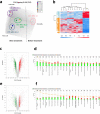Selective treatment pressure in colon cancer drives the molecular profile of resistant circulating tumor cell clones
- PMID: 33557844
- PMCID: PMC7869222
- DOI: 10.1186/s12943-021-01326-6
Selective treatment pressure in colon cancer drives the molecular profile of resistant circulating tumor cell clones
Abstract
The characterization of circulating tumor cells (CTCs) holds promises for precision medicine because these cells are an important clinical indicator of treatment efficacy. We established the first and still only nine permanent colon CTC lines from peripheral blood samples of a patient with metastatic colon cancer collected at different time points during treatment and cancer progression. The study objectives were (i) to compare the gene expression profiles of these CTC lines, and (ii) to determine the main features acquired during treatment. The number of upregulated genes was higher in the CTC lines obtained after treatment, indicating that they acquired properties to escape treatment pressure. Among these upregulated genes, some are involved in the mTOR and PI3K/AKT signaling pathways. Moreover, cytidine deaminase expression was significantly increased in the CTC lines obtained after failure of the first- and second-line 5-fluorouracile-based treatments, suggesting that these CTCs can eliminate this specific drug and resist to therapy. Several enzymes involved in xenobiotic metabolism also were upregulated after treatment, suggesting the activation of detoxification mechanisms in response to chemotherapy. Finally, the significant higher expression of aldolase B in four of the six CTC lines obtained after treatment withdrawal and cancer progression indicated that these clones originated from liver metastases. In conclusion, these CTC lines generated at different time points during treatment of metastatic colon cancer in a single patient are characterized by the deregulation of different genes that promote (i) drug resistance, (ii) xenobiotic and energy metabolism, and (iii) stem cell properties and plasticity.
Trial registration: ClinicalTrials.gov NCT01596790.
Keywords: ALDOB; CDA; Circulating tumor cells; Clonal evolution; Colon cancer; Gene expression.
Conflict of interest statement
CAP declare to have had an honorarium from Menarini. The other authors declare that they have no competing interests.
Figures


References
Publication types
MeSH terms
Substances
Associated data
LinkOut - more resources
Full Text Sources
Other Literature Sources
Medical
Miscellaneous

